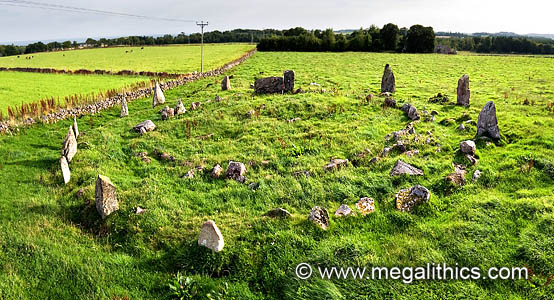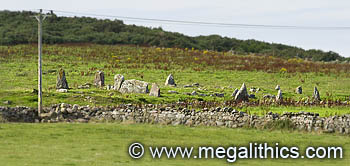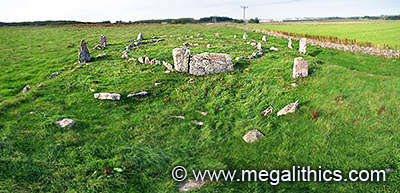

 |
 |
|
More Photos |
||
|
|
Panoramas |
||||
|
|
Infrared |
||||
|
|
3D Vision |
||||
|
|
Antiquarian |
| NO 90184 96337 (GPS 83min) | Diameter 22.9m (pub.) |
| Visited August 1987, August 2010 | Altitude 190m OD |
Auchquorthies, also known as Aquorthies, Aquhorties, Aquhorties North, Aquhorties Manor and Hillhead of Aquhorties, is a recumbent stone circle (RSC) situated about 10km south of Aberdeen, less than a kilometre from the A90 opposite the town of Portlethen. The circle stands in pasture land and is built on a small natural knoll that resembles an artificial platform (see later), the site has a pronounced slope towards the NE. Auchquorthies is in a very good state pf preservation and the internal ring cairn is one of the most intact we have seen.
Auchquhorthies is mentioned in the Old Statistical Account of 1791 (1) as "a Druidical temple worthy of notice" its condition is described as "remarkably perfect". Also described is the discovery; on the east side of the site between the outer kerb and the circle, of a "stone chest" "3 feet long, and 11/2feet wide". An "urn" was discovered in this cist but was found to contain "nothing but a little dust or ashes". Logan (2) published an account of the circle in 1829 along with a plan drawing, the eastern flanker being absent in this. Logan called the circle "Auchorthie" and described how "Most part of the exterior line of stones has been filled up, to constitute a fence". He commented on something we noticed during our visits to the RSCs, "The Altar stone is always plain on the outside" in other words the outer face of the recumbent is often very flat, Logan thought this to be intentional (as do we) saying "I doubt whether it has not been produced by art".
Thomson (3) refers to the circle as "Anquhorthies" and gives measurements of the three stone rings, he describes digging in front of the recumbent and finding nothing. He also dug "the whole area of the innermost circle" finding "charcoal, half-calcined bones, black unctuous earth, and small fragments of a vase". Chrisitian Maclagan (4) published a plan sketch of the circle in her work of 1875, but she was convinced that Auchquhorthies, along with all of the RSCs was actually the remains of a broch-like building, the space between the outer kerbs and the circle being filled with an immense masonry wall. She saw the recumbent stones as the fallen lintels of the entrance passages of these structures. Smith (5) paid a brief visit to "Auchorthies" in 1880, he published measurements of the three rings and added that the circle was "both interesting and imposing, and is an ornament to the place". He mentions that a "Celtic authority" told him that the name meant "The field of scarcity".

Auchquhorthies was visited by the inimitable Fred Coles as part of his great survey of Scottish circles, his account (6) published in 1899 gives extensive measurements of the site and informs that the recumbent weighs 10tons 9cwt . Curiously, like Maclagan, Fred also places the recumbent at the SW when it is actually at the south, if anything, it is slightly east of south. We can only guess that the local magnetic variation was considerable over a hundred years ago and that this is the cause.
The circle's good state of preservation may be due, in part, to some supernatural protection. Burl (7) describes how a poor man removed a slab from the site to use as a hearth at home, but he was then "troubled with a deal of noise and din about his house in the night time, until he carried back the stone to the place where he found it". Others were not so easily deterred, on the 30th of Sept 1858 Charles Dalrymple, Alexander Thomson, and four other gentlemen "examined" the centre of Auchquorthies with the aid of "two or three active labourers and the necessary tools". Their investigations could not have taken much time however, as they also managed to dig the Cairnwell Clava ring-cairn and the circles of Old Bourtreebush and Craighead of Badentoy in the same day!

As mentioned above, the circle is built on a raised knoll about 23m x 40m that resembles an artificial platform, indeed Burl describes it as just that, "an irregular stony platform", "raised to create a level site". After visiting the site, we can definitely state that the site is anything but level, it has a pronounced slope to the NE which is clearly visible in some of our photos (above) and panoramas, also current opinion is that the raised "platform" is actually a natural knoll.
The wonderful state of preservation clearly reveals the three concentric rings of the stone circle and the inner and outer ring-cairn kerbs, although sadly, the eastern flanker is missing. About 12 stones of the surrounding stone circle remain in place on a true circle, but there is some controversy regarding its original form (see later). The circle stones are of local reddish granite and range in height from 2.4m at the SW to 1.1m at the north, the 10 largest stones show typical RSC height grading. The recumbent stone is not set on the circumference of the stone circle and has been positioned between this and the outer kerb of the ring cairn. This is a common trait in Kincardineshire RSCs, but Auchquhorthies is the most extreme example, with the recumbent closer to the kerb than the circle.

The recumbent measures 2.8m x 1.3m and is approximately 0.8m thick, when viewed from the side (which is facilitated by the missing flanker) it has a "knife-edge" profile, the outer face being particularly flat. The western flanker stands 1.7m tall and the eastern flanker is missing, both the flanker and the recumbent are of a coarse grained grey granite that contains many quartz inclusions. Burl sees the differing petrology of the recumbent and flanker as evidence of a non-local source, this may not have been a choice made because of their composition, but rather their size, as the recumbent and flankers are usually the largest stones present in a RSC. Another trait of Kincardineshire RSCs is that the recumbent is not set as far west as other RSCs and Auchquorthies shows this also with the recumbent standing just east of south at 174 degrees.

An unusual feature is the "forecourt" structure formed by rows of small stones set between two of the circle stones and the flanker locations. The enclosed trapezoid area before the recumbent being reminiscent of the forecourts of some chambered tombs.
The internal ring-cairn is bounded by an outer kerb of contiguous stones some 15.4m in diameter that even today is largely intact. The stones of this kerb are height graded in the same manner as those of the surrounding stone circle, generally ranging from 0.7m at the SW/E to only 0.3m at the north, the tallest kerb is at the ESE and is 1m tall. As mentioned above, the recumbent and flanker stand outside of the line of outer kerbs, and the W flanker has been joined to the kerb ring by the use of an extremely long (1.8m) stone, Fred Coles' plan shows a similar, now vanished, stone connecting the location of the E flanker. The inner kerbs of the ring-cairn have mostly vanished with only 5 remaining, these are substantial rectangular slabs 0.7m high, closely fitted together on a circle of about 3.2m. The huge mass of small boulders that would have filled the space between the two kerb rings has been robbed away long ago.
There has been much speculation regarding the unusual features of this site, some point to the extreme setting back of the recumbent and Logan's account of the insertion of extra stones into the circle to suggest that the present stone circle form is not original, and that the recumbent once stood on the circumference of the circle, the two stones to the south of the recumbent being later insertions or outliers (8). We have tried setting true circles through all of the remaining large circle stones and the recumbent, the only situation that gives a satisfactory fit is with all of the stones included and the recumbent set well back (as shown in the plan, top of page). There is also uncertainty regarding the original stone count, the 10 largest existing stones show good grading and positioning and they could be the survivors from an original 11-12 stone ring. There is also a suggestion that the the circle was comprised of the large circle stones with small pillars inserted between each pair, this would fit with the existence of the two surviving smaller circle stones.
Auchquorthies is inter-visible and very close to another RSC, Old Bourtreebush, the two circles being only 300m apart. Sadly Old Bourtreebush has not been as lucky as Auchquorthies, and has been extensively ruined over the ages. We revisited Old Bourtreebush on the same day as Auchquorthies and our coverage of that circle will eventually be expanded to match.
1.
Old Statisical Account of Scotland, 4, p.456, 1791-9.
2.
Logan J., Archaeologia, 22, p.200-202, 1829.
3.
Thomson A., Proceedings of the Society of Antiquaries of
Scotland, 5, p.133-4,
1865.
4.
Maclagan C., The Hillforts, Stone Circles and Other Structural Remains of
Ancient Scotland, p.13, Edmonston and Douglas, Edinburgh, 1875.
5.
Smith R.A., Proceedings of the Society of Antiquaries of
Scotland, 14, p.305-6,
1880.
6. Coles F.R.,
Proceedings of the Society of Antiquaries of Scotland, 34, p.143-9,
1899.
7. Burl A.
A Guide to the Stone Circles of Britain, Ireland and Brittany,
p.136, Yale University Press, 1995,
New Haven & London.
8. Barnatt J., Stone
Circles of Britain, BAR 215 (ii), p.270, Oxford, 1989.